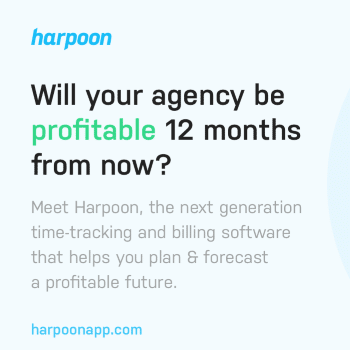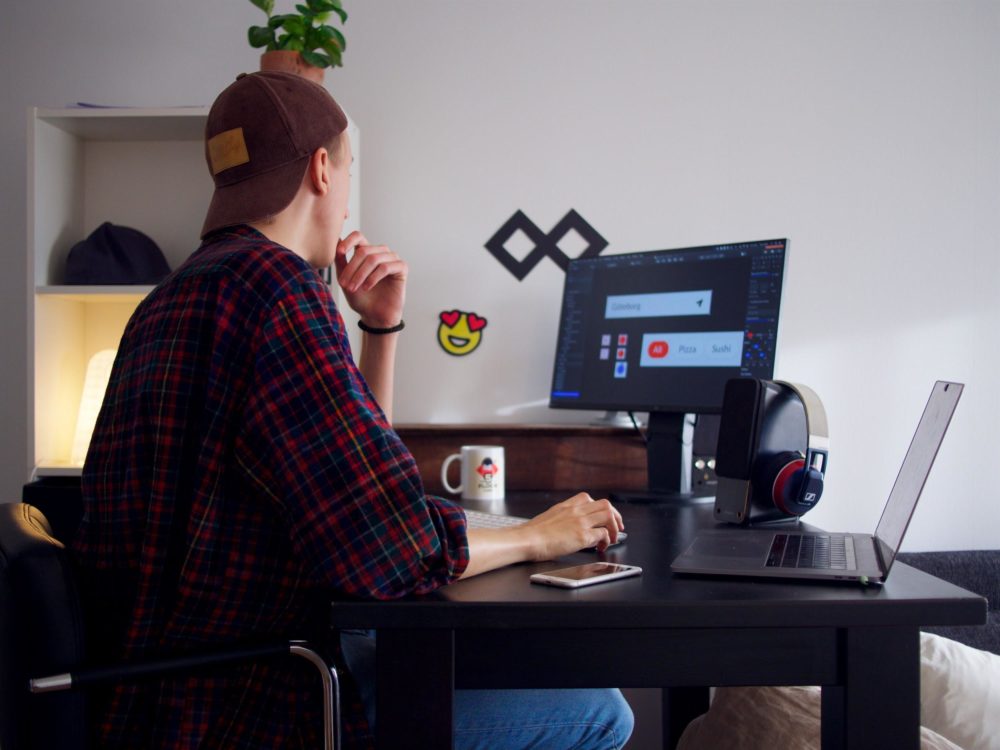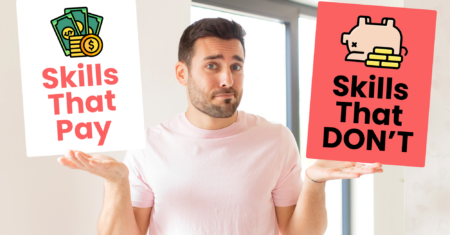You’ve probably come across a ton of successful stories about people who started their freelancing career from scratch are now earning a six-figure salary. Their success may have swept you off your feet, and you are now wondering how to freelance so you can join them.
Well, you are right on time. Freelancing opportunities are steadily increasing as more companies are shifting to remote work.
Now more than ever, you can change from a 9-5 job to a full-time career in freelancing. However, to do so, you need a comprehensive strategy to get started.
To help you navigate the turbulent waters of freelancing and build a sustainable career, here is an in-depth guide, illustrating how to freelance in ten actionable steps. So, let’s dive right in.
Money Note: If an extra $1K–$5K/month would change your 2026 goals (debt, savings, travel, freedom), you’ll want to catch this: free live workshop from a freelancer who’s earned $4M+ online. No fluff. No gimmicks. A real roadmap. 👉 Watch the training or save your seat here »
Here’s how to freelance from scratch:
Freelancing may seem challenging from a beginner’s point of view. You might be overwhelmed because of the diverse viewpoints on how to get started. Or you might feel overwhelmed with all the terminology used to do business as a freelancer.
However, that shouldn’t be the case. With the right guidance, you’ll find freelancing enjoyable and worth pursuing. That’s precisely what this article intends to do; cut through the information overload and point you in the right direction.
Read on to find out the step-by-step procedure on starting your freelancing career and growing it into a sustainable business.
Step 1: Find out If Freelancing is Right for You
The idea of being your own boss is enticing. I mean, who doesn’t fancy working on their terms? Yet it is for this reason that you must ask yourself if you are cut out for a career in freelancing.
To be successful at freelancing, you must be a self-starter, disciplined, and reliable individual. Professionalism and the ability to work on several projects at once while continuously pursuing other opportunities are part of what it takes to establish a freelancing career.
To thrive as a freelancer, you also might need additional tools. These could include time management apps like Traqq to enhance your productivity or invoicing software like Bloom to ensure you are paid accurately. You might also consider all-in-one tools like Moxie or CRM tools like Keap.
It will help if you have the right mindset about self-employment to succeed at freelancing.
However, if you think being your own boss means free time to do whatever you want, whenever you feel like, freelancing might not be for you. It will require continued commitment and strong will-power as a freelancer unlike when employed.
Step 2: Research About the Service You Want to Offer
Just like offline services, the online marketplace boasts a wide range of opportunities. As a beginner, you might find it challenging to choose one.
To know which route is perfect for you, assess your past work experience, passion, and skills. You may have a background in writing, virtual assistance, web design, bookkeeping, internet marketing, or resume writing, among other skills.
A clear overview of your interest helps you to articulate the service you are best equipped to offer.
Once you settle with a service, let’s say writing, you have to go further and gather as much information as possible. This is because writing is broad. You must have an overview of what freelance writing is about, the services you can offer as a writer, and to whom you can offer your services.
Step 3: Identify a Profitable Niche
Finding a niche is very important because a million other people are offering the same service you intend to provide. It would be best if you were specific about your target market and the particular service you are offering.
When picking a niche, narrow down your services to a specific area. You’ll find it easier to hone your skills, provide quality service, and charge premium rates.
If we continue with our previous example, in writing, you can decide to be a copywriter, blogger, social media content creator, or an article writer, just to mention a few. You can be deliberate and further narrow down to target a specific group, like offering copywriting services for start-up IT firms.
To increase your competency, enroll in reputable programs that can set you apart from your competitors. Clients are drawn to service providers who can prove their expertise.
Step 4: Choose a Platform
There are many freelance platforms out there. However, you must be strategic and smart when choosing the one to join. To find jobs that meet your salary expectation and niche, you have to check the freelance job sites’ reviews to find out the right site for you. Some places to start are SolidGigs, FlexJobs, Upwork, and Fiverr.
There are a lot of blogs that give reviews on this, upon doing a quick Google search.
Another thing to look into is the terms of service. Each freelance site has policies that stipulate client-freelance relationships and working terms. Before you sign up, ensure the terms are favorable, and you’ve understood what is required of you.
The internet has a pool of clients, so don’t limit yourself to freelance job sites only—leverage social media. With LinkedIn, Facebook, and Twitter accounts, you can easily connect with potential clients. The catch is to ensure your profile on these sites reflect the services you are offering.

Step 5: Create a Profile
Once you have settled for a job site (or multiple), the next step is to sign up and create a profile. Your profile gives a client the first impression about who you are and what you can offer. Therefore, it must be on point.
Articulate your experience, education, skills, and field of expertise. Be clear on why you are the best choice in your niche. Let your profile be an accurate representation of what you can deliver.
Wrap it up with a clear smiling picture of yourself. It helps when a client can put a face to the profile. I mean, no one wants to work with a “ghost” or mickey mouse. Have a picture of yourself.
Depending on the site you choose, your account may be approved immediately, or it may take several days. Once approved, you are set to work. Other times, it might not be approved. When that happens, do not give up. Note down the error you made and try again.
Step 6: Build a Portfolio
Once your profile is up, you need to show proof of your experience to find clients. To create your portfolio, you can search for trending topics within your niche and have several write-ups of 300 words. If you are a web designer, your website is the perfect sample.
You can also offer your services at a subsidized rate. The best way to do this is to search for your first client among your friends, family, or former colleagues. People who already know you.
Another option is to publish on sites like Medium or HuffPost. There are a dozen other publications you can source for writing opportunities. You can also guest post on authoritative blogs in your niche.
Display the samples and the links of your writings along with your profile on the freelance job site. You can also use these samples when applying for a project. Here, you’ll attach a sample of your work to the proposal.
Step 7: Determine Your Rates
The rates you charge will often reflect your level of experience and the quality of service you deliver. You don’t have to replicate what others are charging, but you can get an idea of the cost of services in your niche by reviewing other freelancers’ prices.
Tailor your prices with your expenses in mind. Thus, do not settle for peanuts because you are a beginner. Charge for the value you are bringing.
As you grow, you can always review your rates and keep adjusting. Do not be afraid to charge a premium. There’s always a market that needs your expertise, and they are willing to pay for the value you are offering.
Use our Freelance Rate Calculator for additional support.

Step 8: Find Work
First, understand the ground rules for bidding on the platform. Lack of compliance may lead to your account being suspended. Next, before you apply for any project, ensure you’ve read and understood the client’s requirements. It’s also important to note how and when you will get paid after the work is done.
When applying, tailor your proposal to answer how you will handle the project. Digress from making the proposal about you.
Instead, turn it around to answer the client’s needs. Briefly highlight your experience and how the projects you’ve done before makes you the best candidate for that project. Customize your experience and skills to the client’s requirements.
It is important to only apply for projects that you can deliver quality work. Getting paid in freelancing is tied to meeting your client’s expectations.
A few great places to start looking for work would be SolidGigs and FlexJobs. With these sites at your fingers, you are more than ready to get started. Another fantastic resource is this massive list of the best freelance job sites.
Step 9: Set Your Goals
Without a coherent plan to create gainful employment from freelancing, you’ll be in the vicious cycle of feast and feminine — a common phenomenon that most freelancers experience because of lack of proper planning.
Therefore, you must have clear, measurable goals of what you want to achieve and how you’ll meet those goals. Your action plan should focus on growing your network and income flow. Focus on short-term and long-term goals. Otherwise, you’ll be stuck on the same spot.
Break down your goals to daily activities that will build up to weekly goals, then monthly achievements, and ultimately career success.
You must have a routine and checklist to ensure all your projects meet the deadlines. Taking steps every day, no matter how small, toward your goals, is the key to realizing the big picture
Step 10: Build Your Brand
The ultimate goal of freelancing is to be the go-to person in your industry. You want to build a brand that stands the test of time. Where you can continuously grow your net worth, remain relevant in your industry, and mentor others.
So, focus on producing quality work. Give each project the attention it deserves. Make it a habit to surpass your client’s expectations. Be professional and create meaningful relationships with your clients.
You can network with freelancers in your industry to get your name out there, and social media allows you to reach a wider audience. So, strive to create meaningful conversations on different platforms.
Upscale your client base so that you can eventually work with reputable companies or individuals in your industry. Lastly, add value to your industry. You might opt to create courses to help others grow or start a mentorship initiative. As you build yourself, build others too.
Tips on How to Freelance Successfully
Now that we’ve answered how to freelance, and you’ve now launched your freelancing career, the next thing is to make sure you are making progress and a decent living out of it. The tips below will help you stay on track and meet your goals.
Determination is the key
When you get negative feedback, do not give up on pitching. Keep pushing until you have a consistent flow of income. Have a daily plan on the number of proposals you’ll send out on the different freelance job sites.
Another plan should be on how much clients’ work you’ll get done by the end of the day. Make weekly projections of how much you want to earn. The tentative income is your reference point and motivation to meet your daily goals.
Polish Your Skills
Keep honing your skills. Enroll for courses in your niche and put into practice every skill you learn. A simple rule to stick to is not to enroll for another course before you practice and polish the skills from the previous course. Otherwise, you’ll be a jack of all trades and a master of none.
Expand your knowledge by being updated on your industry trends. Read freelancing books. Listen to freelancing podcasts. Learn from freelancers on YouTube. Invest in courses for freelancers. You must never stop learning.
Take Charge of Your Finances
Freelance job sites often take 5%-20% of your earnings. Ensure you factor this when deciding the cost of your services or when working with a client with a predetermined budget. When you are working with a client directly, always negotiate for an upfront payment and get a contract signed.
Track your income by recording the cash each project is producing. Record your expenses too. Some apps can help you track your finances easily. Lastly, make sure you balance your account. It’s the only way to know if you are making progress.
The sky is not the limit, you are
The only limitation when it comes to how far you can take your freelancing career is you. You get to define how much you can grow and how fast. And you can start from $100 to $10,000 or more per month. The choice is yours. Be relentless until you achieve your goals.
Keep the conversation going...
Over 10,000 of us are having daily conversations over in our free Facebook group and we'd love to see you there. Join us!




